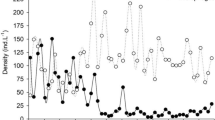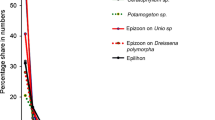Abstract
Seasonal changes in abundance and species composition of rotifers were surveyed at five locations under different physical and chemical conditions in the south basin of Lake Biwa during July 1987–June 1988. Total density of rotifers showed similar seasonal fluctuation with three peaks, although the maximum density showed north (low)-south (high) gradient. Polyarthra spp. (P. vulgaris and P. dolichoptera with low density) dominated except during July–October 1987 and April–May 1988. In the former period the species of Brachionus, Trichocerca, Filinia and Hexarthra, and in the latter, those of Synchaeta, Keratella and Kellicottia had somewhat different proportions in the communities of north and south stations, respectively. The difference in composition during July–October suggests a difference of trophic state between the northern and southern areas in the south basin of Lake Biwa. However, the dominance of Polyarthra and the difference in the composition during April–May 1988 could not be explained by such a difference in trophic state. No critical difference was observed in the community structure of the eastern area of the south basin, where the seasonal fluctuations in nutrient levels and phytoplankton community structure were different from other areas in the south basin. The present results, therefore, suggest that physical and chemical conditions were not effective in controlling the rotifer community structure in the south basin of Lake Biwa.
Similar content being viewed by others
References
Berner-Fankhauser, H., 1987. The influence of sampling strategy on the apparent population dynamics of planktonic rotifers. Hydrobiologia 147: 181–188.
Bērziņš, B. & B. Pejler, 1987. Rotifer occurrence in relation to pH. Hydrobiologia 147: 107–116.
Bērziņš, B. & B. Pejler, 1989a. Rotifer occurrence in relation to temperature. Hydrobiologia 175: 223–231.
Bērziņš, B. & B. Pejler, 1989b. Rotifer occurrence in relation to oxygen content. Hydrobiologia 183: 165–172.
Billets, B. & J. A. Osborne, 1985. Zooplankton abundance and diversity in Spring Lake, Florida. Florida Scientist 48: 129–139.
Buikema, A. L. Jr., J. D. Miller &W. H. Jr. Yongue, 1978. Effects of algae and protozoans on the dynamics of Polyarthra vulgaris. Verh. int. Ver. Limnol. 20: 2395–2399.
Gannon, J. E. & R. Stemberger, 1978. Zooplankton (especially crustacean and rotifers) as indicators of water quality. Trans. am. Microsc. Soc. 97: 16–35.
Gilbert, J. J. & K. G. Bogdan, 1984. Rotifer grazing: in situ studies on selectivity and rates. In D. G. Meyers & J. R. Strickler (eds), Trophic interactions within aquatic ecosystems. AAAS Selected Symposium 85. Westview Press.: 97–133.
Hillbricht-Ilkowska, A., 1983a. Response of planktonic rotifers to the eutrophication process and to the autumnal shift of blooms in Lake Biwa, Japan. I. Changes in abundance and composition of rotifers. Jap. J. Limnol. 44: 93–106.
Hillbricht-Ilkowska, A., 1983b. Response of planktonic rotifers to the eutrophication process and to the autumnal shift of blooms in Lake Biwa, Japan. II. Changes in fecundity and turnover time of the dominant species. Jap. J. Limnol. 44: 107–115.
Ichise, S. & T. Wakabayashi, 1987a. The seasonal succession of zooplanktons in Lake Biwa. — 1982–1985 - Rep. Shiga Pref. Inst. Pub. Hlth. & Envir. Sci. 22: 62–74.
Ichise, S. & T. Wakabayashi, 1987b. The seasonal succession of planktons at several points in Lake Biwa in 1986. Rep. Shiga Pref. Inst. Pub. Hlth. & Envir. Sci. 22: 75–87.
Kirk, K. L., 1991. Inorganic parameters alter competition in grazing plankton: The role of selective feeding. Ecology 72: 915–923.
Makarewicz, J. & G. E. Likens, 1979. Structure and function of the zooplankton community of Mirror Lake, New Hampshire. Ecol. Monogr. 49: 109–127.
Mäemets, A., 1983. Rotifers as indicators of lake types in Estonia. Hydrobiologia 104: 357–361.
May, L., 1983. Rotifer occurrence in relation to water temperature in Loch Leven, Scotland. Hydrobiologia 104: 311–315.
May, L., 1985. The use of procaine hydrochloride in the preparation of rotifer samples for counting. Verh. int. Ver. Limnol. 22: 2987–2990.
Mizuno, N. & E. Takahashi (eds), 1991. An illustrated guide to freshwater zooplankton in Japan. Toukai Daigaku Shuppankai, 532 pp. (in Japanese).
Nakanishi, M., T. Narita, O. Mitamura, N. Suzuki & K. Okamoto, 1986. Horizontal distribution and seasonal change of chlorophyll a concentration in the south basin of Lake Biwa. Jap. J. Limnol. 47: 155–164.
Nakanishi, M., T. Narita, N. Suzuki & O. Mitamura, 1988. Assimilation number and primary productivity of phytoplankton in the south basin of Lake Biwa. Jap. J. Limnol. 49: 175–184.
Nakanishi, M., O. Mitamura & T. Matsubara, 1990a. Sestonic C:N:P ratios in the south basin of the Lake Biwa with special attention to nutritional state of phytoplankton. Jap. J. Limnol. 51: 185–189.
Nakanishi, M., T. Matsubara, O. Mitamura & M. B. Xavier, 1990b. A comparison of phytoplankton community structure between different locations in the south basin of Lake Biwa. Mem. Fac. Sci. Kyoto Univ. Ser. Biol. 14: 1–11.
Pejler, B., 1983. Zooplanktonic indicators of trophy and their food. Hydrobiologia 101: 111–114.
Sigfried, C. A., J. Bloomfield & W. Sutherland, 1989. Planktonic rotifer community structure in Adirondack, New York, USA in relation to acidity, trophic status and related water quality characteristics. Hydrobiologia 175: 33–48.
Sĺadeček, V., 1973. System of water quality from biological point of view. Arch. Hydrobiol. Beih./Ergeben. Limnol. 7: 1–218.
Tezuka, Y., 1984. Seasonal variations of dominant phytoplankton, chlorophyll a and nutrient levels in pelagic regions of Lake Biwa. Jap. J. Limnol. 45: 26–37.
Walz, N., H. J. Elster & M. Mezger, 1987. The development of the rotifer community structure in Lake Constance during its eutrophication. Arch. Hydrobiol./Suppl. 74: 452–487.
Zankai, N. P., 1989. Horizontal distribution of rotifer plankton along a trophic gradient in Lake Balaton: changes of community structure and abundance during the past 20 years. Arch. Hydrobiol. 115: 111–123.
Author information
Authors and Affiliations
Rights and permissions
About this article
Cite this article
Matsubara, T. Rotifer community structure in the south basin of Lake Biwa. Hydrobiologia 271, 1–10 (1993). https://doi.org/10.1007/BF00005690
Received:
Revised:
Accepted:
Issue Date:
DOI: https://doi.org/10.1007/BF00005690




